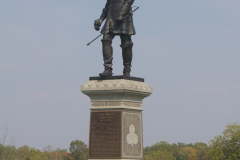Dedicated: 1988.
Location: Hancock Avenue.
Description: Portrait of Brig. Gen. John Gibbon stands on a columnic, castellated pedestal and a tiered base. He is dressed in uniform, with a wide-brimmed hat. He holds his sword and scabbard in his proper left hand. He holds field glasses in the proper right hand which is extended back, as the figure is in mid-stride. John Gibbon (1827-1896) commanded the 2nd Division of Winfield S. Hancock’s 2nd Corps of the Army of the Potomac. Though it took until 1988 to erect a monument to General Gibbon, an article discussing the Gettysburg Monument Commission’s original recommendation to the governor to erect a monument to General Gibbon appeared in 1913. The monument cost roughly $80,000. The base was reused from a Pennsylvania GAR Cemetery.
National Park Service List of Classified Monuments Number: MN802.
Sculptor: T. Jones
 About Major General John Gibbon
About Major General John Gibbon
Born on April 20, 1827, Gibbon came from a prominent Philadelphia medical family; his great grand-nephew (also named John Gibbon) was the inventor of the heart-lung machine in the 1950s.
Gibbon grew up in North Carolina and graduated from West Point in 1847. He wrote an artillery manual and when the Civil War broke out, he remained loyal to the Union although three of his brothers and two of his brothers in law chose to fight for the Confederacy; he was also a cousin of General Pettigrew, who commanded a brigade in Heth’s Division at Gettysburg.
Gibbon was given command of western troops who became famous as “The Iron Brigade” and rose to division command by the time of Fredericksburg. Temporarily given command of the Second Corps on July 2 at Gettysburg, he was wounded on July 3 and was present for the dedication of the Gettysburg National Cemetery. He later commanded the XXIV Corps in the Army of the James.
After the Civil War, Gibbon played a prominent role in the Plains Indian Wars. He died on February 6, 1896, and he was buried in Arlington National Cemetery. His monument was a late addition to the battlefield; it was dedicated on the 125th anniversary in 1988. Several towns in varying states are named for him.








